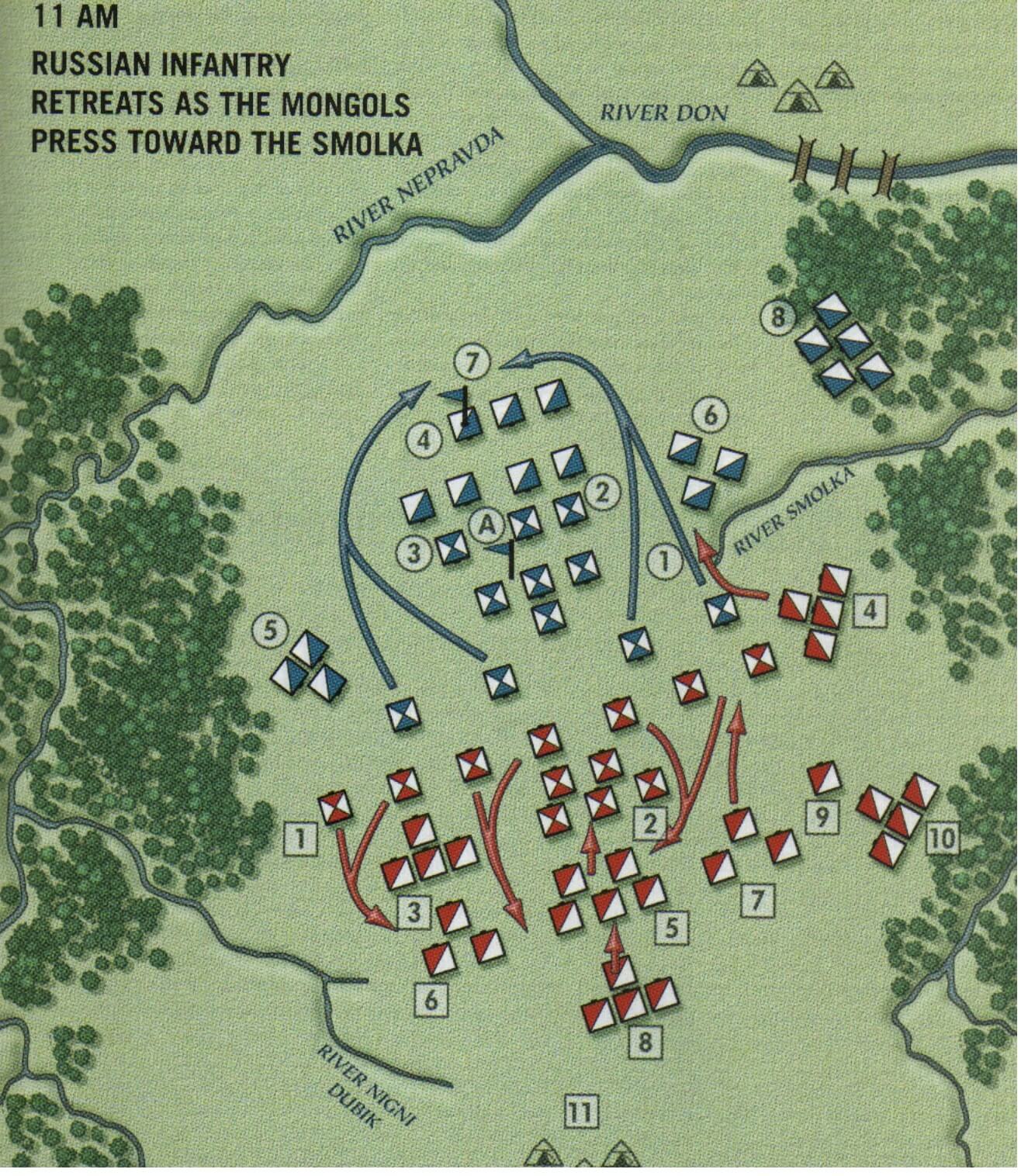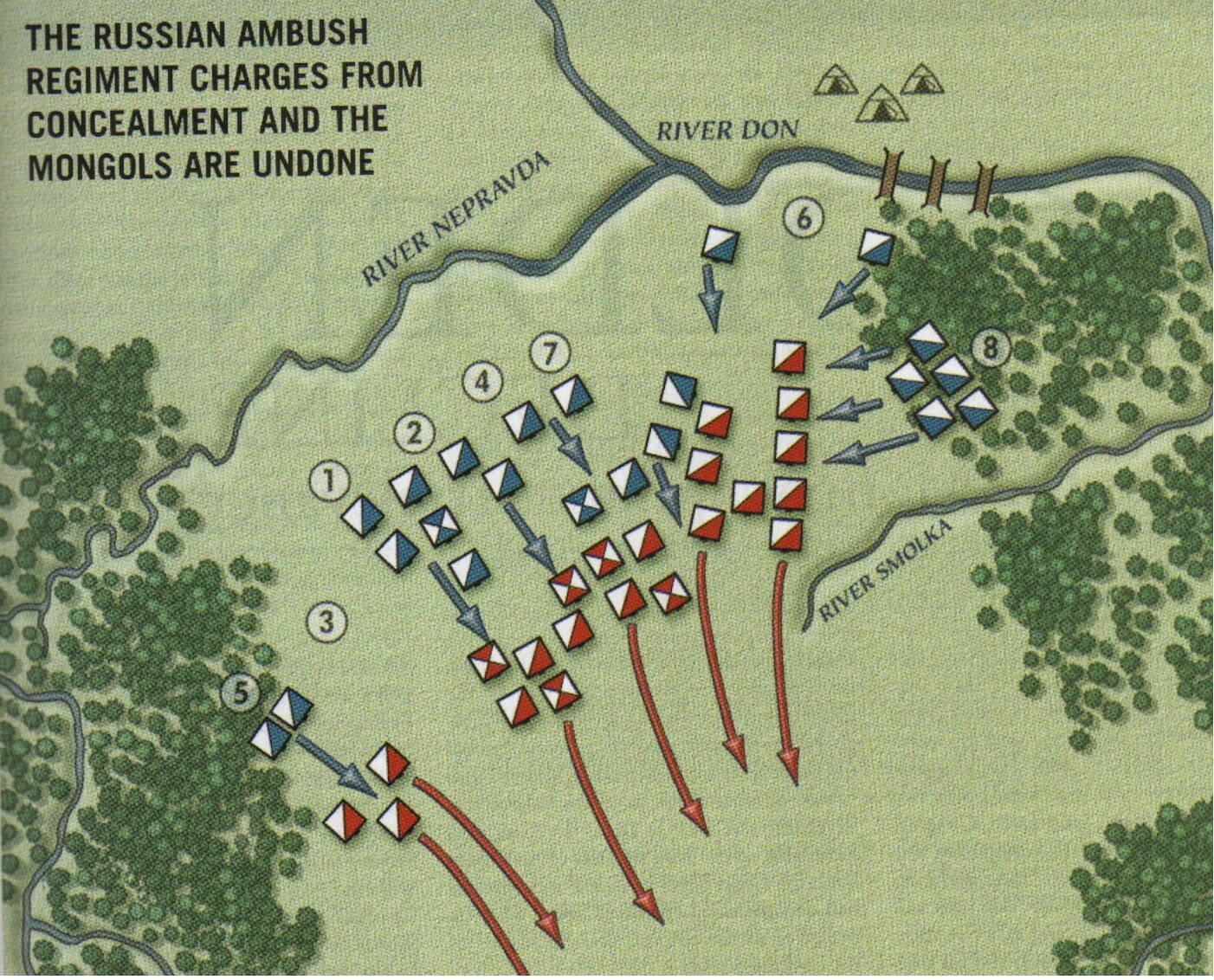As a fan of the Infidel, Men of Iron series the discovery of 2 additional scenarios in Against The Odds (ATO) magazines was a boon.
A friend agreed to loan his punched versions to me. Sweet. A little light reading for period flavor helped me understand the context and import of this battle and its place in history. The articles about the Mongols are well worth reading. They cover 14th Century Russia, the disintegration of the Mongols and some insights into just how powerful the Hordes were across history (we will save that for another post).
1380 is the same year that Charles the VI was crowned king at 12. It is just 40 years after The Black Death had swept through Europe. The Ottoman Empire was on the rise, the 100 Years War was in full swing and the Great Schism was in play. Chaucer wrote, Martini and Bondone were early Renaissance figures writing and painting.
Against this backdrop the Russian Principalities were subject to pressure for Lituania, and hands off suzerainty from the descendent hordes of Temujin. As long as taxes were paid the life and religion of the principalities were lets largely alone. Yet for some the yoke of subjugation, and the call of consolidated power were enough to say no to this Yellow Horde.
After a successful battle at the Voja crossing in 1378, Dmitri lead his coalition of supporters in a desperate battle two years later to cast off the Mogol influence.

Kulikovo is not the end of Mongol influence, rather it is the seminal battle that proved that the Mongols were not invincible, that a united front could defeat any enemy, and the central importance of Moscow. The primary developments that aided this change in Russian fortunes was Dimitri and other leaders development of their own cavalry forces capabilities and the ability to choose the location of the conflict. An adoption of armor and weaponry from the West made an impact in force effectiveness.
Whilst Mongol forces had stayed roughly the same in terms of weapons and tactics, the Russians had evolved. A minority had heavy almost cataphract style horse armour, with mail and early plate armor, protected the horsemen. Their arms included long thrusting broadswords and lances with swords. Maces began to make an appearance. The changes meant that archer based and focussed cavalry blended with heavy cavalry of their own were at a disadvantage. Plus the added benefit of the Russian foot soldiers with long spears helped protect forces from light cavalry charges, backed up by crossbowmen and foot archers of their own.
Using the Infidel system from 2010/11 with this game from December 2006 is simple. The rules are based off of MoI which was released in 2005.
There are two nice touches taken from the history. Firstly the “False Dimitri”, know as an aggressive leader they dress a retainer up in his garb, and he is of course killed. You get to play with that as a special scenario rule, allowing for this subterfuge. The second Special Scenario Rule kicks off the action. Both sides presented a hero to fight for them as a good omen. The winner gets initiative. In actual fact both sides heroes were killed in their initial charge. Only the Russian chap stayed in the saddle…thereby winning…ahem….;)
Most battles in Infidel as you can imagine involve swirling cavalry battles, frequent changes of initiative, and comparison between two very different combat styles, and force mixtures. Here we do not have that situation.
Whilst in reality the Heavy Cavalry (HC) of each force was likely very different that does not seem to come out in this battle. In fact both forces despite a slight size advantage have very similar make up of Foot/Archer/Light Cavalry/Heavy Cavalry . This fact combined with the specific terrain the Dimitri elected to fight in means that the fighting will be very stilted.
You can see immediately that the terrain is hilly, with crests, slopes, and steep sides (well actually the steps are really difficult to see) and forests. The map is easy on the eye, but very monochromatic. Every thing is infused with a yellow tinge. Whilst nothing compares to the abortive, and “ugly is in the eye of the beholder ” Suliman map this is more challenging to play on due to the color scheme.
NO IMAGES see Bigboard @ Facebook for shots.

After a handful of rounds of Archery fire from foot troops the Right Wing closes to attack, in rough terrain. Mostly foot use archer as hit and run tactics here are very difficult due to terrain cost. These counters are a delight by the way.

A blend of Medium (MC) and LC advance in between other formations. Closed terrain is a challenge. the movement is severely inhibited. +1 up a slope, +1 for crests…..yikes.

After over a dozen activations little progress has been made. Both sides are playing conservatively, retreating disordered units and recovering then moving back into the fray. The army frontages are very tight!

The forces on both sides are evenly matched, the Russians are losing more units however. The incessant flow of Mongol units takes its toll. Note however that die rolls are critical. Especially given the relative similarities of forces. Unless enemy forces are disorganized first attacks can go awry quickly as seen above.
The ability to bring hit and run tactics with LC archers is critical, but terrain and crowding restrict this key feature. This mirrors the action in the early stages of the battle.

On the Russian Left Yaro fights MC to MC, inconclusively, one eliminated Tartar, one disrupted Russo unit. The Rout points at this stage are 13 to 9. We have done 51 activations!

Ok…. the game wins. After meticulously rotating yet another sequence of LC in to Fire, and then out, whilst the MC advance to rout a single unit I realized this is not fun. We are fulfilling the history accurately, but there is not fun in here. Even with some ahistorical play I am not able to budge this attrition based dog fight!
Which is the first time this has happened with this series for me! The constricted terrain, and eye wearying map are a bad combination with the forces capabilities being too evenly matched to allow decisive blows. Due to this fact the there are lack of modifiers (DRMS) which means wild swings in results.
Whilst all that is ‘reasonable’ it ain’t fun!
So let me cap this one off by saying that the after several hours of real combat the Russians were being beaten back. As the Mongols advanced into the rolling open plains towards the river the Ambush regiment struck. Routing the forces of the Horde.
I highly recommend the Men of Iron series in general. I am having a hard time saying that about this particular scenario, however the articles in the magazine may be worth the price of admission for the completist. I was going to play the Sulieman battle but I could not get past the atrocious, map, ghastly counters and their fiddly size. I literally threw the game back in the bag. The attempt at ‘period feel’ whilst brave was not well executed. https://www.facebook.com/media/set/?set=a.246431068797555.54026.132246893549307&type=1
[images from ATO magazine Vol2 Nr.2]
The final result of the battle above meant not the end of the Hordes but another 50-100 years of conflict. In fact Moscow was raised twice. Yet it was the actions of Dimitri that begun the nascent birth of a federation of principalities that would eventually become know as Russia.

